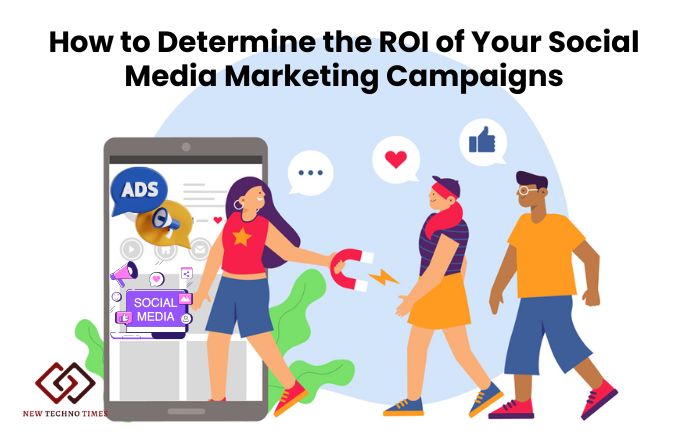Do you remember the last time you checked your social media activity results? Has your money and time on social media marketing provided any results? Businesses and marketers are running towards Facebook, Instagram, and LinkedIn, hoping to convert to returns, but the lack of tracking often leads to a dead-end.
Understanding if the campaign is working or not through ROI measurements is essential. ROI enables you to understand the value you get from your expenditures. Calculating Social Media ROI can be a daunting task.
Measuring the most dominant metrics and knowing how to utilize the apparent information can turn a blind platform into many smarts. This article aims to equip you with that knowledge, regardless of your expertise level in marketing.
What is Social Media ROI?
Social media ROI entails the estimated profit you can receive, according to the ROI mentioned, per advertisement on various social media sites like Facebook or X (formerly Twitter). The cost incurred for ad content management and appraised revenue in terms of sales or prospective clients will quantify the two core focuses of social media ROI.
The basic formula is:
ROI = (Return – Investment) / Investment × 100
If you spent $1,000 on ads and made $3,000 in sales, your ROI is:
($3,000 – $1,000) / $1,000 × 100 = 200%
ROI, however, is more than just sales. If the activity pertains to business results, it can also encapsulate likes, shares, followers, and engagement. That is the core reason why determining the type of return expected guides the efforts in clearly understanding why tracking ROI is crucial.
Also Read: Is QR Codes for Successful Digital Marketing Campaigns?
Set Clear Goals Before You Begin
Measurable ROI begins with a set goal. The goal is tied to the business type and what the individual wants to achieve through the social media campaign of one’s choice.
Some common goals include:
- Increased website visits
- Lead generation
- Email list expansion
- Sales increment
- Improved brand visibility.
- Enhanced customer interaction.
Like every other measurable metric, goals also have to be SMART. They must be Specific, Measurable, Achievable, Relevant, and Time-bound. On the contrary, instead of saying “increase followers,” say, “gain 1,000 new followers on Instagram within three months.”
A clear goal leads to an equally clear path for measuring and tracking progress for measuring and monitoring progress.
Track the Right Metrics (KPIs)
Choose key performance indicators. KPIs (Key Performance Indicators) assist in measuring success. Choosing the right ones depends on your campaign goals. Here are a few examples:
- Reach & Impressions: Number of people that saw your content or your content showed up.
- Engagement: Liking, commenting, sharing, and saving.
- Click Through Rate (CTR): The number of clicks divided by impressions.
- Conversion Rate: Number of people who take action, such as buying or signing up.
- Cost Per Click (CPC): Money spent for each click.
- Customer Acquisition Cost (CAC): The total cost of getting one new customer.
- Sales Revenue: Sales that directly came from your campaign.
You can gather the data using Google Analytics, Facebook insights, or the Instagram Business dashboard; these data also break down what’s working and what’s not.
Assign Value to Each Action
Most actions proposed do not lead to one directly buying a product but instead are of value. For affiliate marketers to define ROI, putting a dollar value on every action is necessary.
Here is how:
- Value estimation of 10% of your leads: statistically buying something worth 200makes1leadvaluedat200makes1leadvaluedat20.
- Estimation of the value coming from a website visit.
- Estimate how valuable trust in a brand leads to further purchases and deeper engagement.
Even a WooCommerce product video that gets shared often can bring future customers. So, if your video leads to 5 sales at $100 each, that content helped generate $500 in value.
Evaluating actions gives you a more vivid image of your ROI.
Also Read: Top 7 Digital Marketing Strategies To Grow Your Small Business in 2023
Tools to Measure ROI
There are numerous tools available to assist you in quickly and accurately measuring the ROI of your social media presence. These are among the best:
Google Analytics
Analyzes traffic to a website, conversions, and identifying goals. It shows the most valuable social platforms for a business.
Meta Business Suite (Facebook & Instagram)
Analyzes performance of posts and adverts. You can analyze reach, clicks, engagement, and overall cost per action.
LinkedIn Campaign Manager
Relevant to B2B campaigns. It Tracks ROI, leads, and engagement from ads on LinkedIn.
Hootsuite & Sprout Social
These tools gather information from various accounts and create custom reports on your brand’s ROI, engagement, and growth.
UTM Parameters
Attach UTM codes to your social media links. This will help you track the source of the traffic and the actions people take after landing on your site.
Calculate ROI Step-by-Step
Let’s start by listing out the steps:
Step 1: Set a Clear Goal
Example: In one month, 100 new email subscribers will be gained.
Step 2: Track All Costs
Consider:
- Spent on advertisements
- Tools and software
- Graphic designing or video production
- Team member’s time (work hours multiplied by a particular value).
Step 3: Measure Results
Example: You now have 150 subscribers instead of 100.
Step 4: Assign Value
If each subscriber is worth $5, 150 subscribers = $750.
Step 5: Use the ROI Formula
If your total cost was $300:
ROI = (750 – 300) / 300 × 100 = 150%
You earned $1.50 for every $1 spent—a positive return.
Also Read: 8 Benefits of Marketing Automation for B2B Companies
Analyze What’s Working (and What’s Not)
Once you have the numbers, you can see what content works best. Look at:
- How many clicks or shares did individual posts receive?
- What advertisement resulted in direct sales or registrations?
- Days or times with the most significant participant interaction.
- The platforms with the most substantial return on investment.
All of the items in this list can be tested using A/B testing strategies to try out new headlines, CTA or visuals that can encourage users. Over time, these subtle methods encourage improved ROI.
Improve ROI with Better Strategies
Boosting your ROI is about making smart changes. Try these tips:
- Incorporate product videos: Videos are eye-catching and informative and provide better drive clicks.
- Emphasize high-performing platforms: Focus more on channels that bring in the most return on investment.
- Improve audience targeting: Use data to target specific age, gender, and interest categories.
- Implement retargeting ads: Advertise to users who have previously visited your website.
- Optimize landing pages: Ensure users are prompted to take action after visiting your page.
- Experiment with multiple ad formats: Use carousel ads, reels, and short videos to your advantage.
- Optimize influencer marketing: Work with micro-influencers to drive better ROI and improve brand trust.
These are just some campaign changes you can implement to improve the profit gained significantly.
Common Mistakes to Avoid
Despite the proven effectiveness of social media, many businesses fail to achieve the desired outcome due to easily avoidable mistakes. Look out for the following:
- Setting improper tracking parameters: Failing to set up UTM links or conversion trackers would make it hard to track metrics.
- Paying too much attention to vanity-related metrics: Popularity and followers are nice to see, but ultimately don’t add value in ROI.
- Not monitoring audience interactions: Failure to track what your audience enjoys can significantly affect your performance.
- Using poor-quality content: Unclear captions and poor-quality images turn people away.
Avoiding these blunders will allow freedom with their budget while improving ROI over time.
Reporting Your Results
Reporting lets you showcase progress to your team, supervisor, or clients. A well-put-together report should feature the following:
- Goals and actual results of the goals set.
- Metrics Key (engagement, reach, CTR, conversions)
- ROI percentage
- What actions were successful and which were not
- Suggestions for next steps.
Your top priority should be simplicity and ease of understanding. Make your report visually appealing by using pie charts and graphs. Creating reports every month will make tracking progress easier.
Also Read: 5 Ways To Improve Your Personal Social Media Presence
Conclusion
Your social media strategy should be laser-focused. Each promotion you run should increase your overall ROI. Additionally, every dollar spent on marketing needs to be measured. Social media ROI can reveal so many hidden secrets.
Setting goals alongside tracking key metrics gives space to ensure the business is seeking growth. Eliminating ambiguity should be your top priority. Use data to enhance campaigns and boost profits smartly. Even a product video can be monumental when done right. Effortlessly measuring business actions will only reveal positive outcomes for marketing strategies.
We, at New Techno Times aim to provide the best technology information to readers to gain knowledge of what is going on in the world around us. For related blogs about cybersecurity and technology, Digital Marketing, Business, Education keep following us.

